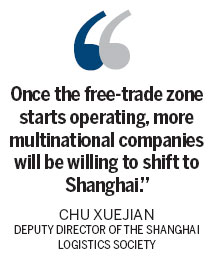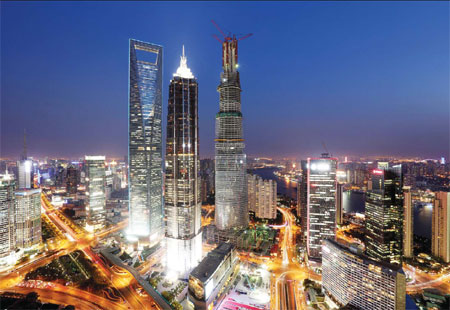Shanghai green light piques others' interest
Updated: 2013-07-12 08:49
By Shi Jing (China Daily)
|
|||||||||||
|
Analysts believe setting up a free-trade zone in Shanghai will strengthen the city's position as a center for trade. Provided to China Daily |

Big companies are keenly watching what happens next after free-trade zone is approved
Approval for a free-trade zone in Shanghai has inspired confidence and created a sense of urgency in some other coastal cities, notably Tianjin and Shenzhen, which harbor similar ambitions and have equally expansive plans.
The State Council approved Shanghai's free-trade zone, which will cover 28 square kilometers and offer world-class transport and communications facilities as well as a tax-free environment.
Shenzhen, which had container throughput of 21.7 million 20-foot equivalent units (TEUs) last year, already has a free-trade zone. But it is small, and its operations are limited by regulatory and other constraints.
About 2,000 kilometers to the north is Tianjin, whose ports handled 12.3 million TEUs last year.
The Tianjian municipal government has submitted a proposal to the State Council to turn the bonded area of Dongjiang into a free-trade zone. Government officials in Dongjiang say the proposal has won in principle support from the State Council and is now soliciting opinions from the departments under the State Council.
The ramifications of the announcement on Shanghai are being closely watched by multinational companies, including many in Europe that have extensive manufacturing and sales operations in Asia.
Eddie Yu, director of the customs department of Ikea China, says news of the Shanghai free-trade zone is very good for the company.
Smaller European exporters could also benefit from greater convenience in inventory control.
Maximilian Spitzy, general manager of Ezee Beverages in Shanghai, which mainly imports wines and spirits from Austria and Germany, says the news is exciting for European wine importers. At present the spirits company's imports attract a 50 percent combined levy, including customs duty and consumption tax.
But Spitzy doubts that the wine and spirits imported to Shanghai will be totally free of tax in the new zone. "The good news is that Chinese consumers will be able to enjoy wine and spirits of better quality at lower prices once the tax is reduced," he says.
Logistics industry insiders have welcomed the competition, and noted that facilities in the three ports serve the needs of different regional markets, which are individually large enough to support more than one free-trade zone.
The central government hopes the Shanghai zone will be promoted and copied to advance reform and opening up.
Yang Xiong, the mayor of Shanghai, said during the Taipei-Shanghai City Forum in Shanghai on July 4 that the city will seize the chance to develop a free-trade zone.
Shanghai sees more reform and opening up as a driving force of economic restructuring, and the city should play its role as a pioneer in reform, Yang says.
A spokesman for United Parcel Service of America Inc says the company "welcomes any policy that will help to promote the development of free trade, improve trade facilitation and accelerate stock turnover".
Zhang Jianhua, a senior manager at the Shanghai branch of the Shenzhen-based logistics company SF Express, says it is too early to say what benefits the zone will bring to logistics companies.
"We will wait for more detailed policies within the free-trade zone before we make any further plans," Zhang says.
Chu Xuejian, deputy director of the Shanghai Logistics Society, says approval of the zone is especially good news for the city, with the development of the existing Waigaoqiao Free Trade Zone and Shanghai itself reaching a bottleneck.
"The economic growth of Shanghai has slowed recently. Establishment of the free-trade zone provides a perfect opportunity for Shanghai to seek new growth points. It is also in line with the municipal government's policy of retreating from secondary industry and entering the tertiary industry. Modern service industries will be given a chance for growth and innovation," Chu says.
At the Waigaoqiao zone, companies have to go through two customs checks, at the port and at the free-trade zone, for clearance, which has prompted many multinational companies to turn to Hong Kong.
At the end of last year, 403 multinational companies had set up regional headquarters in Shanghai, a government report delivered at the Shanghai People's Congress on Jan 27 says.
"Once the free-trade zone starts operating, more and more multinational companies will be willing to shift to Shanghai. Trade flow will be smoother by that time."
As long as the municipal government has a clear goal of combining the city's role of an economic, financial, shipping and trade center, Shanghai is sure to grow into the hinterland of Northeast Asia, Chu says.
Tianjin, for its part, expressed its intention of building up a free-trade zone long before China became a member of the World Trade Organization in 2001.
The Tianjin Bonded Logistics Park obtained approval from the State Council in August, 2004. Ever since its dry run in May 2005, tax has been reimbursed for domestically made goods once they enter the park.
Authorities at the Dongjiang Free-Trade Port Zone of Tianjin have aimed to transform the port into a free-trade zone focusing on financial leasing, offshore finance and international shipping.
Yu Rumin, chairman of Tianjin Port Holdings Co Ltd, said in 2011 that "setting up a free-trade zone based on the Dongjiang Free-Trade Port Zone will be an effective way for Tianjin to further open up".
Shenzhen has sought to expand its free-trade zone over the years. It was the first Chinese city to establish a free-trade zone.
The local authorities of the Yantian District of Shenzhen studied the feasibility of establishing a free-trade zone as early as 2008. Li Xiuzhong, a member of Shenzhen People's Political Consultative Conference, wrote a proposal in 2010 calling for faster progress in setting up a free-trade zone in Yantian.
Li wrote in the proposal that Yantian had met all the requirements to develop a zone by 2007. The container throughput of Yantian exceeded 10 million TEUs in 2007. By that time, Yantian had been the top among the 10 largest Chinese ports for more than four years.
Qu Jian, deputy director of the China Development Institute, a think tank in Shenzhen, says the city has been working hard to get central government approval for a free-trade zone.
Even though the free-trade zone in Shanghai will be the first of its kind in China, another free-trade zone in Shenzhen does not mean duplication.
"For a large economy like China, it is of course better to have more free-trade zones," Qu says.
"The area that a free-trade zone covers is quite small, usually covering no more than 30 square kilometers. It is better to have one free-trade zone in every economic region, such as the Yangtze River Delta region and the Pearl River Delta region, so a complete network of free-trade zones can be built. Economic restructuring will be made possible under such a system."
shijing@chinadaily.com.cn
(China Daily European Weekly 07/12/2013 page14)
Today's Top News
List of approved GM food clarified
ID checks for express deliveries in Guangdong
Govt to expand elderly care
University asks freshmen to sign suicide disclaimer
Tibet gears up for new climbing season
Media asked to promote Sino-Indian ties
Shots fired at Washington Navy Yard
Minimum growth rate set at 7%
Hot Topics
Lunar probe , China growth forecasts, Emission rules get tougher, China seen through 'colored lens', International board,
Editor's Picks

|

|

|

|

|

|






